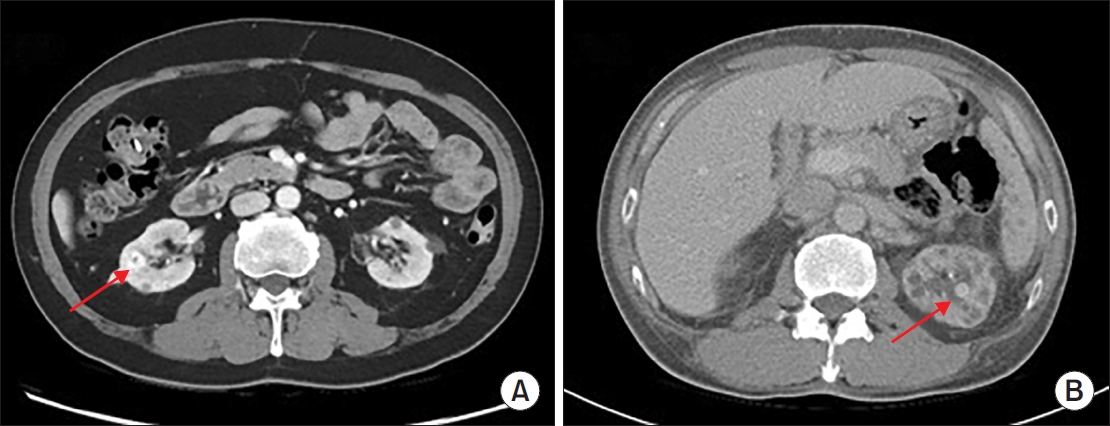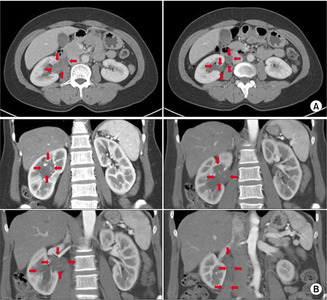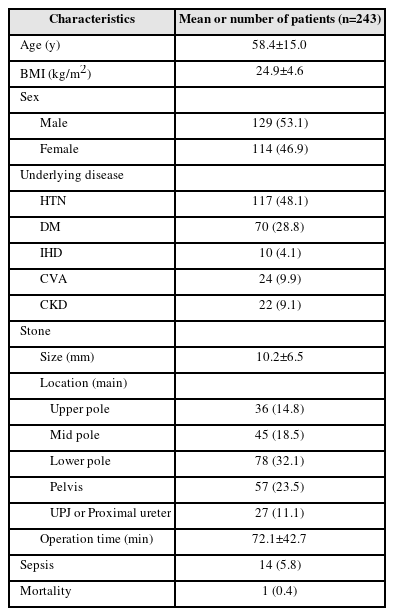Search
- Page Path
- HOME > Search
Review Article
- Regenerative Medicine for the Kidney
- Vladimir Mashanov, Ji Hyun Kim
- Urogenit Tract Infect 2025;20(3):144-158. Published online December 31, 2025
- DOI: https://doi.org/10.14777/uti.2550028014
-
 Abstract
Abstract
 PDF
PDF - Kidney disease poses a major and growing global health challenge, with both prevalence and mortality continuing to rise. Current standard-of-care treatments, including dialysis and kidney transplantation, have significant limitations and do not adequately meet clinical needs. This unmet need has driven the development of next-generation regenerative medicine strategies, which can be broadly categorized into 3 areas: (1) approaches that enhance the kidney’s limited intrinsic regenerative capacity; (2) stem cell-based therapies; and (3) implantable bioengineered kidney constructs. This review summarizes recent advances in each of these domains and discusses the major biological, technical, and regulatory challenges that must be addressed to enable successful clinical translation.
- 3 View
- 0 Download

Case Report
- Hemangioma Mistaken for Renal Cell Carcinoma in a Patient With End-Stage Renal Disease: A Case Report
- Hyung-Lae Lee, Dong-Gi Lee, Jeong Woo Lee, Jeonghyouk Choi
- Urogenit Tract Infect 2025;20(1):48-51. Published online April 30, 2025
- DOI: https://doi.org/10.14777/uti.2550008004

-
 Abstract
Abstract
 PDF
PDF PubReader
PubReader ePub
ePub - Hemangiomas are rare, benign vascular neoplasms that are more common in patients with end-stage renal disease. Here, we describe 2 cases of hemangioma misdiagnosed as renal cell carcinoma before renal transplantation. The key finding in our case was the misdiagnosis of hemangiomas as renal cell carcinoma based on computed tomography and magnetic resonance imaging in patients with end-stage renal disease. Because living transplantation was planned for our patients, we performed rapid surgical resection of the heterogeneously enhancing renal masses to avoid delays in transplantation. Our case highlights the importance of rapid surgical resection of enhanced renal masses to confirm diagnosis, thereby avoiding delays in patients scheduled for renal transplantation.
-
Citations
Citations to this article as recorded by- Editorial for UTI 2025 Vol. 20 No. 1 - Highlights of This Issue’s Papers and the UTI Editors’ Pick
Koo Han Yoo
Urogenital Tract Infection.2025; 20(1): 1. CrossRef
- Editorial for UTI 2025 Vol. 20 No. 1 - Highlights of This Issue’s Papers and the UTI Editors’ Pick
- 1,415 View
- 17 Download
- 1 Crossref

Original Article
- Effect of Residual Stone Fragments on Patient-Reported Quality of Life after Endoscopic Kidney Stone Surgery
- Sang Hee Lee, Jun-Koo Kang, Jae-Wook Chung, Yun-Sok Ha, Jun Nyung Lee, Seock Hwan Choi, Hyun Tae Kim, Tae-Hwan Kim, Eun Sang Yoo, Tae Gyun Kwon, Bum Soo Kim
- Urogenit Tract Infect 2024;19(2):31-39. Published online August 31, 2024
- DOI: https://doi.org/10.14777/uti.2024.19.2.31

-
 Abstract
Abstract
 PDF
PDF PubReader
PubReader ePub
ePub - Purpose: This study examined the effects of residual fragments (RF) on the patient-reported quality of life (QOL) after kidney stone surgery, such as retrograde intrarenal surgery (RIRS) and percutaneous nephrolithotomy (PCNL), using the Korean version of the Wisconsin Stone Quality of Life Questionnaire (K-WISQOL).
Materials and Methods: The medical records of 156 patients who underwent RIRS or PCNL and completed the preoperative and postoperative K-WISQOL from January 2021 to September 2023 were analyzed retrospectively. The patients were divided into RIRS and PCNL groups by the surgical method. The participants completed the K-WISQOL within four weeks before and after treatment. The patients’ baseline characteristics, surgical outcomes, and K-WISQOL scores were compared according to the presence of RF in each surgical group.
Results: Of the 156 patients, 95 underwent RIRS, and 61 underwent PCNL. In the RIRS group, the patients’ baseline characteristics and surgical outcomes were similar in the stone-free (SF) and RF subgroups. The changes in all K-WISQOL domain scores and total scores were similar in the two subgroups. In the PCNL group, the RF subgroup had a significantly higher proportion of staghorn stones, a significantly larger mean stone diameter and significantly longer operation time than those of the SF subgroup. But, the changes in all K-WISQOL domain scores and total scores were not significantly different between the two subgroups, as observed in the RIRS group.
Conclusions: This study showed that the presence of RFs after endoscopic kidney surgery did not affect the short-term patient-reported QOL regardless of the surgical methods.
- 2,786 View
- 35 Download

Case Report
- Giant Fibroepithelial Polyp in the Renal Pelvis to the Upper Ureter
- Kyung Jin Chung
- Urogenit Tract Infect 2023;18(3):119-122. Published online December 31, 2023
- DOI: https://doi.org/10.14777/uti.2023.18.3.119

-
 Abstract
Abstract
 PDF
PDF PubReader
PubReader ePub
ePub - Benign ureteral tumors are rare owing to the predominance of malignancies in ureter tumors. Among them, fibroepithelial polyps are very rare, and giant fibroepithelial polyps are even rarer. This paper reports the author’s experience of giant fibroepithelial polyps detected incidentally. A 47-year-old woman was referred for severe right flank pain to the author’s center. A kidney computed tomogram revealed a long soft tissue lesion in the right kidney, upper polar calyx, pelvis, and whole proximal ureter with hydronephrosis. The radiologic reading was right renal pelvis urothelial cancer. Endoscopic removal was deemed impossible because the mass was filling the entire renal pelvis and upper ureter, so a nephroureterectomy was performed. After the nephroureterectomy, the pathology findings revealed a giant fibroepithelial polyp. This paper reports the treatment of giant fibroepithelial polyps of the ureter. Clinicians should consider the possibility of benign tumors and recommend a cautious approach to treatment if discovered.
- 2,087 View
- 16 Download

Original Article
- Risk Factors for Sepsis after Retrograde Intrarenal Surgery: Single Center Experience
- Jinseok Kang, Koo Han Yoo, Taesoo Choi, Gyeong Eun Min, Dong-Gi Lee, Hyung-Lae Lee, Jeonghyouk Choi
- Urogenit Tract Infect 2023;18(3):93-100. Published online December 31, 2023
- DOI: https://doi.org/10.14777/uti.2023.18.3.93

-
 Abstract
Abstract
 PDF
PDF PubReader
PubReader ePub
ePub - Purpose: To evaluate risk factors for sepsis after retrograde intrarenal surgery for treatment of renal stones.
Materials and Methods: We analyzed the clinical data of 243 patients with kidney stones who visited our institution between April 2017 and April 2023. Age, sex, body mass index, underlying disease, location and size of stones, previous history of stones, previous history of urinary tract infections, duration of surgery, preoperative drainage, application of ureteral balloon dilation, and laboratory test results were included in the analysis.
Results: The mean age of the patients was 58.4 (±15.0) years; there were more men (53.1%) than women (46.9%). Of the 243 patients, the overall rate of sepsis was 5.8% (n=14) and the total mortality rate was 0.4% (n=1). In univariate analysis, history of urinary tract infection (p=0.019), positive preoperative urine culture test (p=0.009), operative duration of more than 90 min (p=0.004), and application of ureter balloon dilation (p=0.016) were statistically significant. In multivariate analysis, positive finding in the urine culture test performed before surgery (p=0.003), operation duration >90 min (p=0.005), and use of balloon dilation during surgery (p=0.011) were statistically significant.
Conclusions: There is a risk of progression to postoperative sepsis if bacteria are detected in the urine culture before surgery, if the operative time exceeds 90 min, or if balloon dilation is performed during surgery. Given that the probability of progression to sepsis is approximately 6%, close observation and active treatment are needed for patients with these risk factors. -
Citations
Citations to this article as recorded by- Establishing an AI-based artifact correction system for intrarenal pressure monitoring using the LithoVue™ Elite ureteroscope: an EAU endourology and AUSET collaboration
Takahiro Yanase, Shuzo Hamamoto, Rei Unno, Steffi Kar Kei Yuen, Vineet Gauhar, Bhaskar K. Somani, Olivier Traxer, Yuya Sasaki, Ryosuke Chaya, Atsushi Okada, Kazumi Taguchi, Takahiro Yasui
World Journal of Urology.2025;[Epub] CrossRef - Analysis of postoperative infection factors of retrograde intrarenal surgery combined with negative pressure equipment for renal stones
Deheng Cui, Qinghong Ma, Qiuyan Zhang, Lian Zhang, Guoqiang Chen
Scientific Reports.2024;[Epub] CrossRef
- Establishing an AI-based artifact correction system for intrarenal pressure monitoring using the LithoVue™ Elite ureteroscope: an EAU endourology and AUSET collaboration
- 4,324 View
- 82 Download
- 2 Crossref

Case Report
- Seminal Vesicle Infection of Zinner Syndrome Misdiagnosed for Neoplasm
- Young Joo Kim
- Urogenit Tract Infect 2020;15(2):54-56. Published online August 31, 2020
- DOI: https://doi.org/10.14777/uti.2020.15.2.54
-
 Abstract
Abstract
 PDF
PDF PubReader
PubReader ePub
ePub - Zinner syndrome is a rare Müllerian duct congenital anomaly representing unilateral renal agenesis, ipsilateral seminal vesicle cyst, and ejaculatory duct obstruction. A 16-year-patient presented with dysuria, nocturia, and enduring diffuse perineal pain for two months. Radiologic studies revealed a right seminal vesicle cyst with a mass lesion and right renal agenesis. Ultrasonography guided transrectal biopsy indicated a seminal vesicle neoplasm. The mass was diagnosed as chronic inflammation. This paper reports a case of seminal vesicle inflammation associated with Zinner syndrome that was initially misdiagnosed as a neoplasm.
- 1,137 View
- 5 Download


 KAUTII
KAUTII

 First
First Prev
Prev


